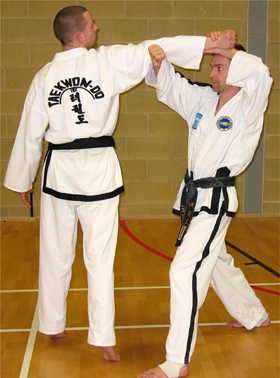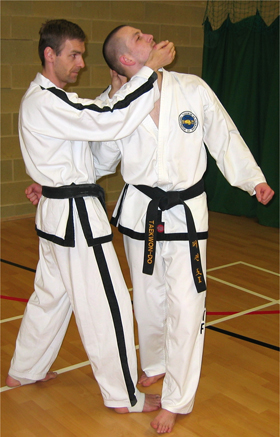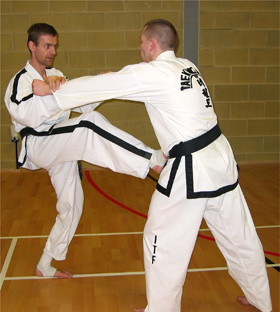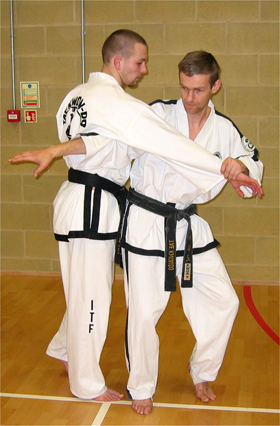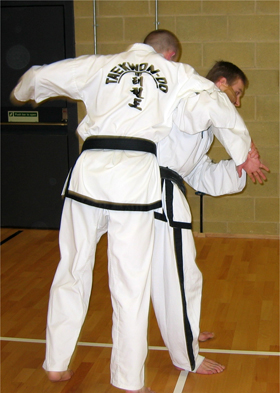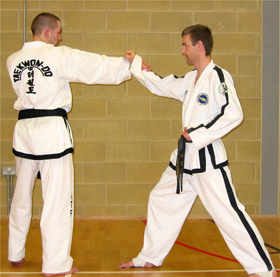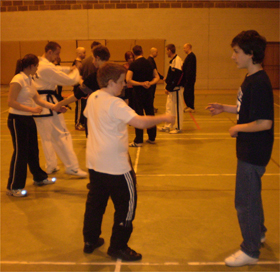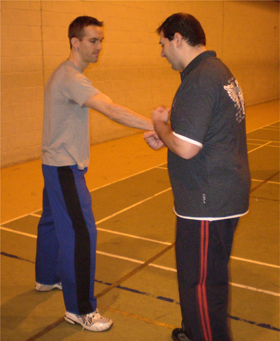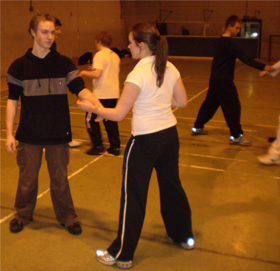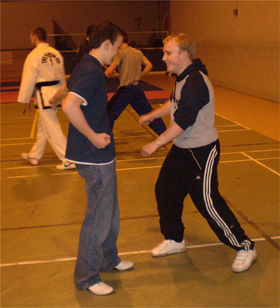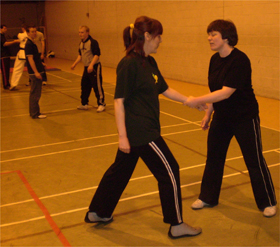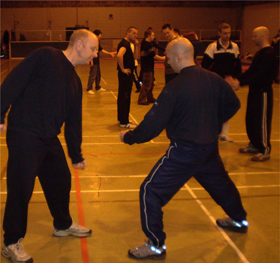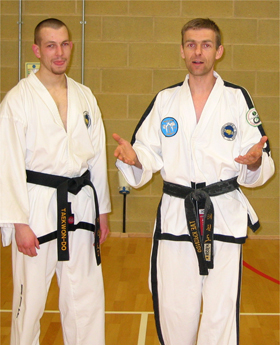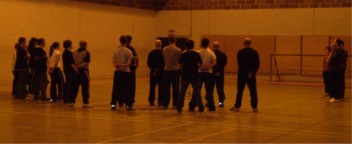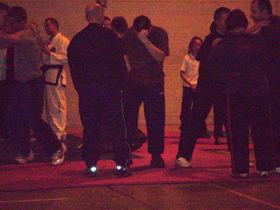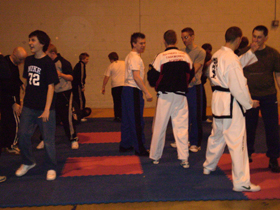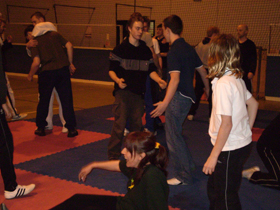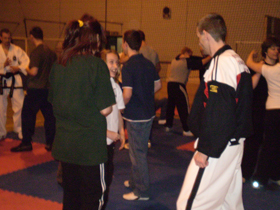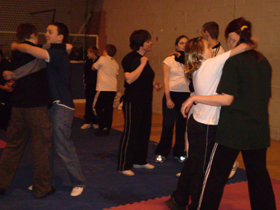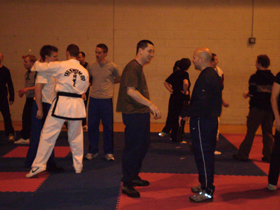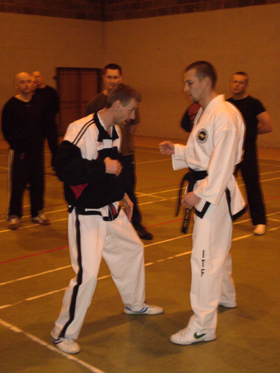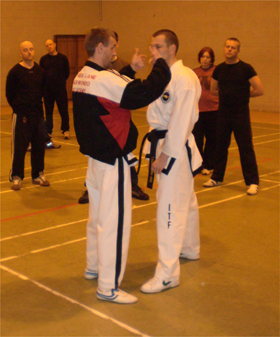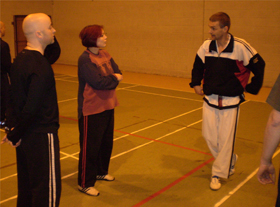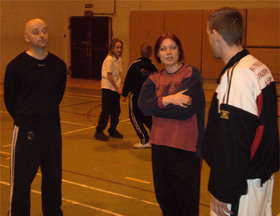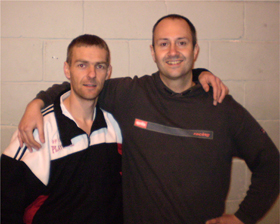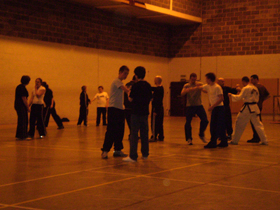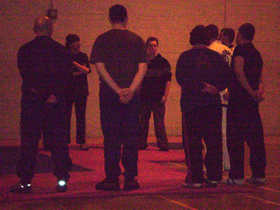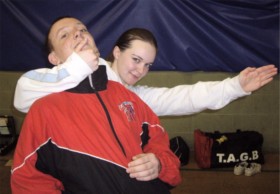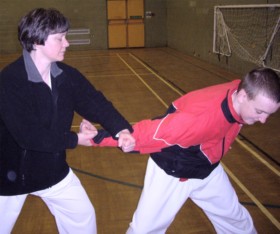REPORT |
Many readers will be familiar with Stuart Anslow's recent book, Taekwon Do Hae Sul,
which takes the Ch'ang Hon pattern set up to Toi Gye and analyses each pattern,
seeking to find applications for the moves other than the occasionally unrealistic
"official" interpretations. This kind of approach has been a growing trend
in the circles of Karate for some time (see the work of Iain Abernethy amongst
others) and is increasingly gaining momentum in Taekwon Do too. Having bought a copy of Stuart's book and been impressed with his work, I'd been corresponding with him for some time via email when I broached the subject of him travelling to my club outside Nottingham to deliver a seminar. In the end he wasn't hard to persuade, so February 11th this year saw Stuart and a good number of students and friends of Southwell Taekwon Do Club meeting at Sport Nottingham for a 2 hour seminar on his work. After brief introductions, the afternoon began with a run through a variety of applications for a simple low block movement. This movement also underlines several of the principles common to many of the alternative applications, so is an excellent starting place for students new to these ideas. Stuart and I share a belief in covering less material in greater detail rather than trying to cover a larger range superficially, so several applications were demonstrated and then students given time to put them into practice with a partner, gradually increasing resistance to a point they were comfortable with. Having seen and drilled the movement as a strike or a release from a wrist grab (among others), we were ready to move onto our pattern proper as I wanted Stuart to take the group through a pattern from start to finish to show how it all flowed in relation to the realistic applications. I had selected Do San as the pattern to work through, partly as it contains many movements common to other patterns, thus forming a good basis for study that can be developed further into other patterns and because all the seminar attendees know the pattern as its one of the lower grade ones. So after completing our introductory section, Stuart moved on to working everyone through the applications of Do San. Each movement was demonstrated by Stuart and his black belt Colin Avis, going over it several times and from several angles to ensure all students had got the essential points regarding the application. The group then moved to work the movement for themselves. As the students trained each application, Stuart and Colin moved around the group, answering questions, making corrections and offering suggestions. In between each movement there were opportunities to ask questions, seek clarification and enjoy the occasional digression into other movements through a quick discussion and demonstration by Stuart. We covered a lot of supplemental material in this way, and Stuart's enthusiasm for his subject drew all the participants in, eager to learn more. It's impossible to give a real flavour of the techniques discussed and demonstrated in this short article; if you want to study this sort of subject in any real way I can only recommend that you get a copy of Stuart's book and begin working on them for yourself. However, some of the ideas included neck cranks and head-control to a throw (double punch and knife hand guarding block respectively) a basic shoulder throw (following on from straight fingertip thrust) and any number of techniques designed specifically for the close range that competitive sparring tends to neglect but self-defence tends to require. Our group contained a wide range of grades, from blue stripe up the 3rd Degree Black Belt, but everyone seemed happy and commented later that they had enjoyed the experience and learned something new. Though we had also intended working through Joong Gun, time passed too quickly and we were only able to complete Do San on the day. Stuart's enthusiasm for his subject was such that there was always another application he wanted to show in answer to a question, or supplemental material he wanted to bring in to emphasise a point. A fascinating insight for all involved! Luckily we had a little leeway with our venue (for which many thanks to the most accommodating Sport Nottingham), and Stuart continued to teach for another 45 minutes beyond the planned end of the seminar. If I hadn't had to call a halt to proceedings I think we might have been there late into the night, as Stuart was happily moving through more ideas and wanting to share more of his research, including some interesting applications nice bits scheduled for volume 2 and the higher grade patterns! It was an excellent afternoon for all involved. Everyone from the most senior grades to the lower got something from the day and enjoyed the opportunity to add something to their study of the Ch'ang Hon pattern set. As the session was based on a particular pattern, students could easily understand the gross movements, as they were all familiar from training the pattern. Taking the basic movement and applying it differently, or in a different situation opened the eyes of many students to the great possibilities contained within their patterns. Similarly, having a familiar pattern to relate to aided students in retaining what they learned. I cannot recommend this method highly enough as a useful training method, both for allowing students to rapidly understand a movement and also to retain an application easily. All my students came away from the day with a new insight into their patterns and a new enthusiasm for training them. Southwell Taekwon Do Club would like to take the opportunity to thank Stuart Anslow and Colin Avis for an excellent afternoon's work, and also Mr Ralph Minott for all his help in getting the seminar arranged. To all students and friends of the club who attended, thank you very much for your support and I look forward to seeing you at the next one! For information regarding training at Southwell Taekwon Do club please contact Paul Mitchell at p.mitchell@nmtkd.org.uk . For further information on Stuart's book please see www.raynerslanetkd.com where you can also order a copy. |

Ch'ang Hon Hae Sul Seminar Report by Sabum Paul Mitchell, II |
Ch'ang Hon Hae Sul Seminar Report by Sabum Paul Mitchell, II |

